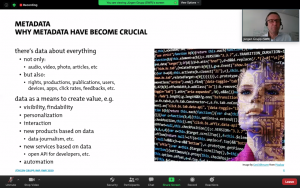<assert qcode="example-org:123">
<name>Acme Financials</name>
<organisationDetails>
<affiliation role="example-affrole:memberOf" type="cpnat:organisation" qcode="example-fingroup:ABC"/>Categories
Archives
 At the 2020 IPTC Spring Meeting in May, the IPTC Standards Committee endorsed version 2.29 of our flagship news markup and syndication standard, NewsML-G2.
At the 2020 IPTC Spring Meeting in May, the IPTC Standards Committee endorsed version 2.29 of our flagship news markup and syndication standard, NewsML-G2.
Version 2.29, including the 2.29 XML Schema, example documents and schema documentation, can be downloaded from https://iptc.org/std/NewsML-G2/2.29/ or from the NewsML-G2 GitHub repository at https://github.com/iptc/newsml-g2.
The NewsML-G2 Guidelines have been updated to reflect the latest changes in the schema. The NewsML-G2 Specification will be updated soon.
Summary of changes in NewsML-G2 2.29
Below we summarise the changes made in version 2.29. A full change history of NewsML-G2 up to and including version 2.28 is documented in Changes to NewsML-G2 and related Standards section of the NewsML-G2 Guidelines.
Affiliation for organisation details
Up to an including v2.28, Affiliations could be expressed only for Persons, using <personDetails>. Recent use cases pointed to the need for Affiliations to be added to Organisations. In order to do this, a new Property Type, OrganisationAffiliationType, has been created. This is a copy of PersonAffiliationType, with the addition of a new attribute group, FlexOrganisationPropType, which enables @role/@roleuri to be used.
Example: Organisation affiliated with another Organisation
Acme Financials is a member of Financial Group ABC
Example: Person affiliated with an Organisation
John Smith is:
-
Employed by Club A
-
Supporter of Club B
<assert qcode="example-pers:22">
<name>John Smith</name>
<personDetails>
<affiliation role="example-affrole:employedBy" type="cpnat:organisation" qcode="example-club:A"/>
<affiliation role="example-affrole:supporterOf" type="cpnat:organisation" qcode="example-club:B"/>Retiring a Scheme
In its initial design, NewsML-G2 provided for Concepts to be retired, by using the @retired attribute of conceptId. As the standard has matured, we have reached the point where entire Schemes need to be retired. The issue, as with retiring Concepts, is how this can be done without breaking existing NewsML-G2 Items.
There are two changes that support this use case:
-
Add the attributes @schemecreated, @schememodified and @schemeretired to
schemeto be used in Catalogs -
Add the attributes @schemecreated, @schememodified and @schemeretired to
schemeMetato be used in Knowledge Items.
For details, see Scheme Metadata and <scheme> properties.
For any questions regarding NewsML-G2, please post to the NewsML-G2 discussion forum.
 On July 1st 2020, IPTC was invited to participate in an online workshop held by the Arab States Broadcasting Union (ASBU).
On July 1st 2020, IPTC was invited to participate in an online workshop held by the Arab States Broadcasting Union (ASBU).
In a joint presentation, Brendan Quinn (IPTC Managing Director) and Robert Schmidt-Nia (Chair of IPTC and consultant with DATAGROUP Consulting Services) spoke on behalf of IPTC and Jürgen Grupp (data architect with the German public broadcaster SWR) spoke on behalf of the European Broadcasting Union.
The invitation was extended to IPTC and EBU because ASBU is looking at creating a common framework for sharing content between ASBU member broadcasters.
Jürgen Grupp started with an overview of why metadata is important in broadcasting and media organisations, and introduced the EBU’s high-level architecture for media, the EBU Class Conceptual Data Model (CCDM). and the EBUCore metadata set. Jürgen then gave examples of how CCDM and EBUCore are implemented by some European broadcasters.
Next, Brendan Quinn introduced IPTC and the IPTC News Architecture, the underlying logical model behind all of IPTC’s standards. We then took a deep dive into some video-related NewsML-G2 constructs like partMeta (used to describe metadata for parts of a video such as the rights and descriptive metadata for multiple time-based shots within a single video file) and contentSet (used to link to multiple renditions of the same video in different formats, resolutions or quality levels).
Then Robert Schmidt-Nia described some real-world examples of implementation of NewsML-G2 and the IPTC News Architecture at broadcasters and news agencies in Europe, in particular touching on the real-world issues of whether to “push” content or to create a “content API” that customers can use to select and download the content that they would like.
A common theme throughout our presentations was that the representation of the data in XML, RDF, JSON or some other format is relatively easy to change, but the important decision is what logical model to use and how to agree on the meaning (semantics) of terms and vocabularies.
A robust question and answer period touched on wide-ranging issues from the choices between XML, RDF and JSON, extending standardised models and vocabularies, and what decisions should be made to decide how to proceed.
This was one of the first meetings of ASBU on this topic and we look forward to assisting them further on their journey to metadata-based content sharing between their members.